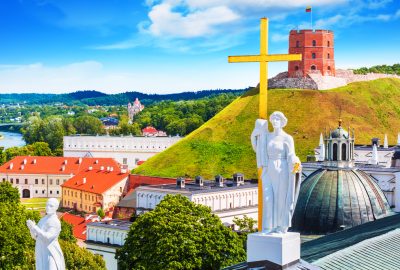When I visited Vilnius for the first time I was barely a teenager. As a Polish high school student, I’ve been taught a lot about the Kingdom of Poland: the great Commonwealth union with Lithuania and portrayed as an unbreakable brotherly bond. Turns out after all that people in Lithuania have an opposite view on all that. They’re being taught that it was an occupation and they don’t really like Polish people all that much. It’s obviously changing and the newer generation doesn’t really care about the past. Instead, they’re looking into the future, which seems to be very promising for them. Despite, or maybe thanks, to its localization Lithuania and Vilnius have made incredible progress, they’re miles ahead of neighbouring countries. They have adopted the Euro and look down in pity on Polish politicians, who are busy Twittering about how they should restore the borders from the era of Polish–Lithuanian Commonwealth.

Old Town of Vilnius: here you will find buildings in different architectural styles from Gothic and Baroque to Art Nouveau and Neoclassicism
Vilnius is simply beautiful, it’s one of those cities that people visit and don’t want to leave. The capital was built around a medieval castle complex from 1419, now there are mostly well-preserved ruins and the Gediminas' Tower, named after the fabled founder of Vilnius. It’s filled with medieval armour and weaponry but it also has one of the best views on the city. The only things that can rival that view are the hot balloon flights, which are quickly gaining in popularity.
The Old Town and the nearby Cathedral Square is another tourist staple in Vilnius. The entire plaza is a perfect meeting spot for locals since it’s a kind of crossroad of the city’s main streets. It’s also where various events take place and where they plant the signature giant Christmas tree; t’s the Times Square of Lithuania. You might recognize the Cathedral if you’ve ever gotten a postcard from Vilnius. It’s the main church and the most important Catholic temple in the country. Yes, it’s beautiful and magnificent and all that, but I bet you’ve seen dozens of those all over the world. What’s really interesting is the tower, standing separate right in front of it. That alone is unusual but the best part is the stories surrounding the enigmatic building. According to new research, it stands on top of an old pagan temple; a religious centre focused around Perkūnas the god of thunder. Lithuania was one of the last European countries to get conquered by Christians and as such, they’re still very close to their pagan heritage.
The Hill of Three Crosses is a very important monument located in the Kalnai Park. There’s a stunning view on the city from the top of the hill. But there’s also an interesting legend involving this particular spot. It is said that seven friars where murdered, beheaded and crucified (either one of those, depending on the sources) because they ridiculed the old gods. Three concrete crosses were built to commemorate that “event”, but there are also pagan shrines hidden all over the park. Word is some kind of worship still takes place there; also the entire country still celebrates spring, fall equinox, and Rasos during midsummer.

The ancient city of Trakai is located 28 kilometers from Vilnius; in the second half of the 14th century there was built a stone castle which the prince of Lithuania used as his residence
I really like that about Vilnius; that old country and old traditions bohemian vibe. It’s very apparent in the Artists Republic of Užupia, an independent part of Vilnius since 1997. Užupia wasn’t the most attractive place to live in, back in the day. So the price of real estate was really low and it became a great area for artists and social rejects to settle in. Spunka (https://spunka.lt/) at Uzhupio g. 9 is an awesome local pub for such people; they say you can even meet some of those infamous Pagans there. You need to try a few traditional dishes exclusive to Lithuania, such as cepelinai potato dumplings filled with all sorts of stuff, or my favourite kind of cake: šakotis, also known as raguolis. One thing that might seem weird to most people is the cold beetroot soup; it’s like borscht but with kefir or yoghurt instead of a hot broth. Add a pinch of dill on top and you got yourself the perfect refreshment for those scorching summer days. Kepta duona is a staple snack that goes great with beer. It’s bread fried with garlic and herbs, served with a cheesy dipping sauce. You’ll have a chance to try those while bar crawling around Vilnius Street, the party central of this enchanting capital.



No one commented yet. Be the first.